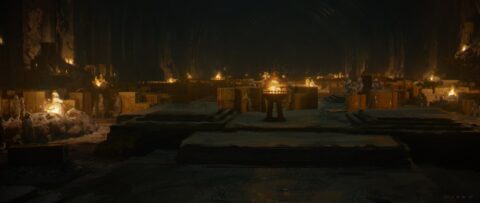You can’t have Percy Jackson and the Olympians without monsters from Greek mythology, and you can’t have monsters from Greek mythology without Medusa.
The iconic, snake-headed figure of Medusa (Jessica Parker Kennedy) appears in the third episode of Percy Jackson and the Olympians. Like every monster in the series, from the Minotaur to Cerberus, she presented a unique set of challenges for the show’s team.
“How do you take something that has a history of interpretations back to clay pots and find something new to do with it that doesn’t break it?” asked executive producer Jon Steinberg on a video call with Mashable.
Guidance came from Rick Riordan’s Percy Jackson books. “The voice that the Percy Jackson universe has helps point you in the right direction,” Steinberg continued. “Everything feels scary and grounded and real, but it also has a bit of a wink through it. That was always the target with all of the monsters, to try to figure out where their humanity was.”
That emphasis on humanity comes through even in the pilot episode, when Sally Jackson (Virginia Kull) tells a young Percy (Azriel Dalman) that not everyone who looks like a monster is a monster. It’s that thinking that leads Percy (Walker Scobell) to initially give Medusa a chance.
She presents herself as an ally to him, Annabeth (Leah Sava Jeffries), and Grover (Aryan Simhadri), as opposed to outright trying to petrify them like she does in the books. She even shares her side of her transformation myth, revealing that she was a victim of Poseidon’s advances. “There’s a turn that happens there, where the more you invest in her story at the beginning as a victim, the more complicated it gets for Percy to kill her,” Steinberg said.

Jessica Parker Kennedy in “Percy Jackson and the Olympians.”
Credit: Disney / David Bukach
All the complication and realistic humanity of Medusa as a character also had to come through visually — even in the nest of snakes coiled around her head. “We never really wanted the snakes to give a performance. They weren’t going to stare at Percy and hiss in unison; that started to feel like you’re in a cartoon,” Steinberg said. “There was something interesting about the idea that part of the immortal torture of Medusa is that it’s really annoying to have snakes on your head. You want to feel the sense of how uncomfortable that must be. So that requires them to be messy and to feel real.”
From there, the visual effects team at Industrial Light and Magic, including visual effects supervisors Erik Henry and Jeff White, set about creating and animating the snakes. This wasn’t Henry’s first time working with snakes: He worked as a visual effects supervisor on 2006’s Snakes on a Plane.
“He had deep, deep experience with what it takes to make a snake look real,” Steinberg said. “And I think from the get-go that [Medusa] was probably the effect that kept him up at night, because a snake moves strangely: the way its muscles move, the way gravity applies to all those mechanics. It’s really easy for that illusion to break down, so a lot of effort went into every snake on her head.”
“It took a lot of time,” added executive producer Dan Shotz. “Not only the specifics of each snake, but how they interact with each other, how they connect. You’re also helped by doing it in the dark. A lot of that scene takes place in the dark, but it also makes it a lot more challenging to pull the details out so that you can really, really feel it and see it.”
As with every visual effect, the process of creating Medusa’s snakes went through several stages. Check out an exclusive clip of the animatic process for our first up-close look at Medusa’s hair, as well as a look at concept art for Medusa’s lair below:

Concept art for Medusa’s lair.
Credit: Disney+
As for the monsters a potential Season 2 might hold, what are Shotz and Steinberg most excited or worried about?
“I feel the same way about Tyson the Cyclops that I did about Medusa, which is that that’s a hard man to make feel real,” Steinberg said of Percy’s half-brother, who first appears in The Sea of Monsters. “And not just to make real as a creature, but so much of the emotional weight of that story rests on Tyson shoulders. So if every time you look at him you’re not fully immersed in his humanity, it won’t work.”
“When I think about the potential of making Season 2, I think about never sleeping,” Shotz said. “We tease Rick all the time like, ‘You didn’t make this easy, man!’ Every season is doubling down on the season that came before.
“But I think what’s also so exciting about the story is all of the worlds,” Shotz continued. “Being able to go to these different places, it never gets stale.”
Percy Jackson and the Olympians is now streaming on Disney+.
Topics
Disney+
